Even during winter months it's possible to see a turtle on Hilton Pond, but only when it's been above 50 degrees for a few days and the sun is shining. Under such conditions Eastern Painted Turtles may haul themselves out to sunbathe atop fallen leaves on a south-facing bank of the pond. Our aquatic Yellowbelly Sliders and Common Snapping Turtles--and terrestrial Eastern Box Turtles--wait for slightly warmer temperatures, so we seldom spot them until spring truly arrives. Our fifth and smallest turtle species is one we've observed only a few times--and never in winter--even though it could be the most abundant shelled reptile at Hilton Pond Center. We speak now of a quiet chelonian that spends most if its time plowing through substrate at pond bottom, searching for snails, worms, crayfish, succulent plant matter, and potential mates; Eastern Mud Turtle is its name.
All text & photos © Hilton Pond Center
Although the Eastern Mud Turtle is well-known as an overland wanderer, only once have we encountered it out of water at the Center, and that was just this week. As we walked a trail across the dam that forms Hilton Pond, we spied a smallish (3.5-inch) tan-colored turtle scooting through the grass, perhaps on its way up from the lower pond below our spillway. We had no trouble catching this slow-moving reptile and carefully grabbed its shell so we could take a closer look. It immediately withdrew its head, legs, and tail but was unable to enclose itself completely as do box turtles. When we peered into the partly closed anterior of its shell (below), the toothless, beak-faced mud turtle peered right back with black and yellow-brown eyes.
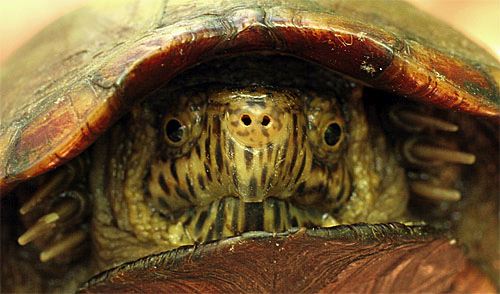
Historically, our favorite method for finding Eastern Mud Turtles was to locate them with our toes while wading Hilton Pond. They're not fast swimmers, and numerous times we've accidentally stepped on one as it prowled the bottom muck for food. We've never been bitten while we held a mud turtle down with our foot or reached underwater to bring it up for a brief examination, but some individuals are reported to be highly aggressive. (Playing footsies like this was also how we discovered that Hilton Pond was home to another shelled but very different bottom-dweller--the Eastern Elliptio clam.)
Eastern Mud Turtles prefer shallow ponds and slow-moving streams but can even be found in brackish water estuaries in the Lowcountry. This is one of a very few North American turtle species that is "euryhaline," i.e., able to survive in water of widely varying salinity. (We've been waiting years to use the word "euryhaline" and, thanks to mud turtles, finally got the chance!) If local freshwater ponds dry up during summer heat, Eastern Mud Turtles may estivate by burrowing a foot or more into moist mud and waiting out the drought. The species occurs from southwestern Connecticut and Long Island NY (where it is listed as an endangered species), and south to Florida and west to southern Missouri and central Texas. In the Carolinas it is most common in the Coastal Plain and essentially absent from the Mountain Province.
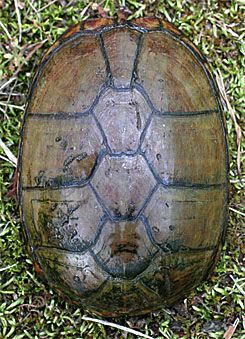 .. ..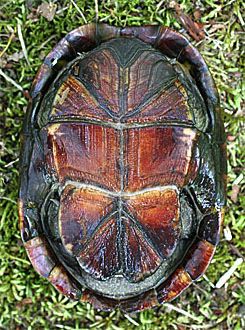
An Eastern Mud Turtle's carapace (i.e., top shell, above left) is quite smooth with very little evidence of growth rings; it is unmarked and somewhat light-colored, although individuals show a great deal of variation from tan to olive to dark brown. There is a double-hinge about a third of the way back on the plastron (bottom shell, above right) that allows the shell to close partway. The plastron can be yellow or brown but in our experience is most often some shade of red--especially bright in hatchlings. This hinged, reddish plastron gives rise to the Eastern Mud Turtle's scientific name of Kinosternon subrubrum, from Greek and Latin words for "moveable chest" and "red beneath." Fairly recently (about 1990), another species--the Striped Mud Turtle, Kinosternon baurii--was documented in North Carolina's Coastal Plain. It usually has three longitudinal stripes on its carapace and a pale head stripe that extends from the nostril through the eye; these markings are very different from the Eastern Mud Turtle's plain carapace and reticulated head.
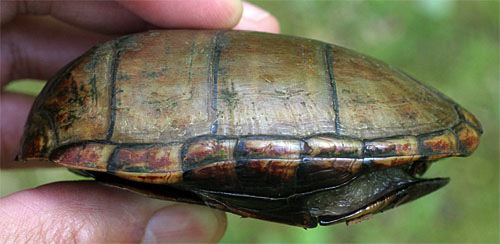
A side view (above) shows the Eastern Mud Turtle's carapace is taller in back, which always reminds us of the PT Cruiser--Chrysler's popular retro automobile. (Despite the physical resemblance, we assume the car's acceleration speed is far greater than that of the turtle.) The photo above also reveals that both the anterior and posterior ends of the plastron can flex, thanks to the cartilaginous hinge absent in most other aquatic turtles. Some authorities report that mud turtles give off a distinctive musky aroma, but the one we encountered this week was essentially odorless--nothing like its similarly sized and extremely pungent relative, the Eastern Musk Turtle, Sternotherus odoratus.
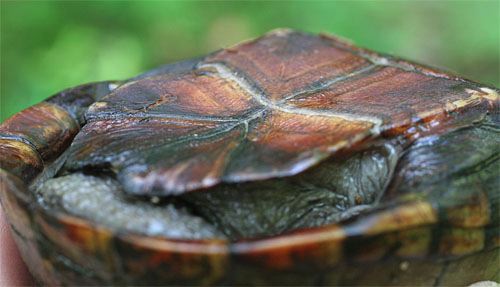
Sexing Eastern Mud Turtles isn't always 100% accurate, but we're pretty confident the individual illustrated here was a male, based on his thick tail tipped with a small spine--plus a concave plastron (above) that enhances his ability to slide onto the female's carapace during copulation. By comparison, the female's plastron is flat or with a slight outward bulge--all the better to provide room for internal development of eggs. Several weeks after mating--which typically happens underwater in late spring--the female mud turtle leaves her pond or stream to find a suitable nesting place. There she first uses her forelegs to excavate a shallow semicircular depression that she deepens with her hind limbs before laying relatively few eggs--typically one to five--and then may or may not cover them with soil or vegetation. The eggs, about half an inch wide by an inch long, have a harder shell than that of most turtles and do not absorb much moisture. Although some Carolinas mud turtlets may break out of the egg and move toward ponds in late summer or early fall, it appears that many hatch and then overwinter in the nest before emerging the following spring. Up to three clutches per female per year have been documented in the South.

One quizzical thing about the Eastern Mud Turtle we recently came across at the Center was the condition of his carapace. The back left quadrant was scarred with indentations (above) that we suspect came from the teeth of a carnivore--probably a domesticated dog that found the wandering reptile one day and played with it a while before losing interest. If that was the case, our slow-moving friend fared better than some of his conspecifics eaten by River Otter, Raccoon, or--when they were still turtlets--a water snake or other predator big enough to swallow them whole. Car and truck tires kill many more adult turtles--particularly females as they seek nesting sites--and draining wetlands takes significant toll. So far, sufficient numbers of Eastern Mud Turtles avoid such difficulties, live several decades, and carry on the species--which we hope is the future of the one we photographed and returned this week to the muddy, murky bottom of Hilton Pond.
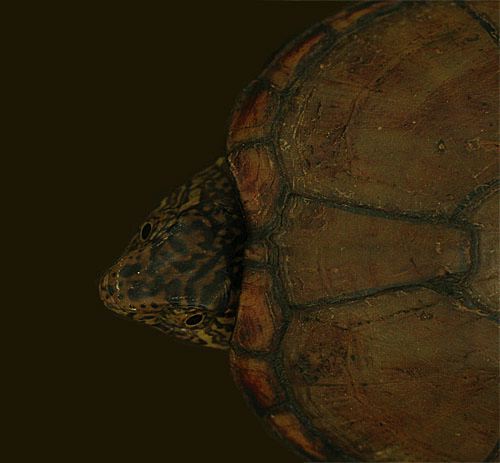
All text & photos © Hilton Pond Center
Comments or questions about this week's installment?
Please send an E-mail message to INFO.
 Be sure to scroll down for an account of all birds banded or recaptured during the week, plus other nature notes of interest. Be sure to scroll down for an account of all birds banded or recaptured during the week, plus other nature notes of interest.
"This Week at Hilton Pond" is written & photographed
by Bill Hilton Jr., executive director of
Hilton Pond Center for Piedmont Natural History.
You may wish to consult our Index of all nature topics covered since February 2000. You can also use the on-line Search Engine at the bottom of this page.
For a free, non-fattening, on-line subscription to "This Week at Hilton Pond," just send us an E-mail with SUBSCRIBE in the Subject line. Please be sure to configure your spam filter to accept E-mails from hiltonpond.org.
|

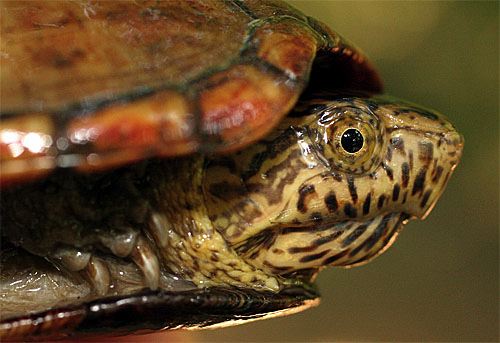

 ..
..






 Please report your
Please report your
